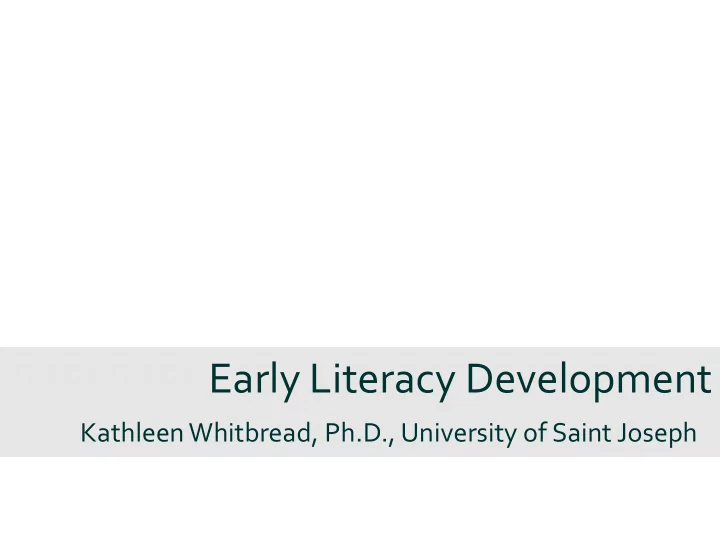

Early Literacy Development Kathleen Whitbread, Ph.D., University of Saint Joseph
Myths ”You should wait until your child is talking before starting reading instruction.” “Children with Ds are sight word readers.” “Reading instruction has to be developmentally appropriate” ”We should focus on functional reading.” “Don’t read books to your child with words she can’t understand.”
We Know What Works Multisensory Systematic Individualized Research based
Okay, so what’s the problem?
All the world’s a stage, and most of us are desperately unrehearsed. Sean O’Casey
Building Blocks of Literacy Comprehension Vocabulary Fluency Phonics Phonemic awareness
Can you run that phonemic awareness thing by me again?
Phonemic Awareness • What sound do these words begin with? boy , box, bike • What is the middle sound in the word sack ? • What word am I saying? /t/………/a/………../p • How many sounds are in the word shop ? • What will I have if I change the /r/ in rug to /m/ ?”
Who’d like to practice?
Phonics • A comprehensive reading program must include phonics • Sight word programs do not generalize to new words
group 3: group 2: group 1: h, k, p, j, v, r, o, g, d t, b, f, n, w, z, q, y x m, c, a, i s, e, u, l 1. Make a list of as many words as you can think of with group 1 letters 2. Write a short story using only words from your list. You may also use these sight words: the, a, is, to, from 11
SYLLABLE TYPES TYPE DESCRIPTION EXAMPLES Closed Ends with consonant; single vowel cat, picnic usually short Open Ends with vowel, usually long he, veto Silent e Silent e, end of the word, long vowel make, like, Vowel team Two vowels together make one pain, head, sound R-controlled Vowel followed by letter r --neither far, or, long nor short harvest Consonant - consonant–le, syllable at end of a apple, le word pickle,
Building Vocabulary Provide a kid-friendly definition share noun a part or portion of a larger amount that is divided among a number of people, or to which a number of people contribute. VS. give part of what you have to someone else
Building Vocabulary • Connect new words to known words • Use the word in lots of different ways • Connect new words to your child’s life • It takes time—keep reinforcing it
Fluency The ability to read accurately, quickly, and with proper expression and comprehension . • Speed may not be the most important priority for very young readers
Comprehension • Comprehension often lags behind decoding in students with Ds • Research supports direct, systematic instruction of comprehension strategies Handout: evidence-based methods of teaching comprehension skills
Learning Profile o Weak auditory working memory o Relative strength in tasks requiring “implicit” memory o More difficulty with “explicit” memory o Strong visual learners o Difficulty processing information presented orally o Motivated by social interaction.
What does this mean for literacy development?
Auditory Working Memory For example: Recalling the sound/symbol associations while blending sounds together to make words Making a ”picture in their head” of a story read or told to them
Memory Implicit Explicit Things you do every Remembering facts, day without really such as names of thinking about them, letters, telephone such as singing a numbers or computer song or signing your passwords) name)
Strong Visual Learners • Difficulty remember rules of language • Sight word reading comes easier than phonics • Difficulty with phonemic awareness activities
How long will this all take? • Recent study (2014) of 140 students with ID – IQs =40-80 (moderate to borderline ID) – Longitudinal, randomized control over 4 yrs. – Systematic, direct, explicit instruction – 45 min/5 days week in small groups – All students made statistically significant growth – 2-4 years to make 1 year of progress
Case Study: Riley -All letter names -Completed Level I and sounds Fundations (Gr. 1) - Fundations Unit 1-4 -decoding early gr. 2, -Phonemic 97% accuracy awareness -comp gr. 1 - • -Completed - Letter names - Fundations Unit Level II Fundations • Some letter 5-10 -decoding grade 2 sounds -decoding CVC • (99% accuracy) Concepts of print words • -comp. Gr 1-2) Begin Fundations - Level I Pre-K Grade k Grade 1 Grade 2 Grade 3
Word Reading Grade 1 SYLLABLE TYPE: Grade 4 40% Short Vowel CVC 100% 20% Consonant Blends /Short Vowels 100% 20% Short Vowel, Digraph, Trigraph 100% -- R-Controlled Vowels 80% -- Long Vowel Spellings 100% -- Variant Vowels 100% -- Low Frequency Spellings 70%
Tips for Families • Read together every day • Give everything a name • Say how much you enjoy reading • Read with fun in your voice • Know when to stop. • Be interactive • Read it again and again • Talk about writing, too • Point out print everywhere www.readingrockets.org
Recommend
More recommend